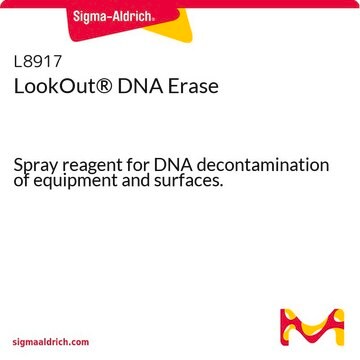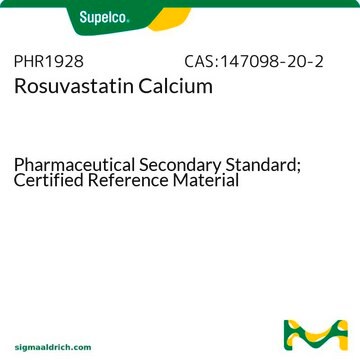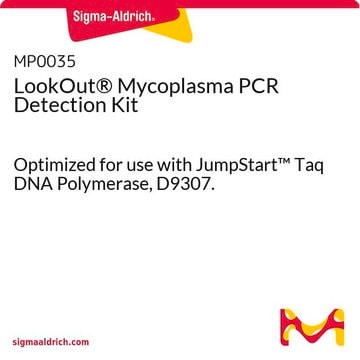43944
DNA decontamination reagent
for removal of DNA on lab equipment
Sinónimos:
DNA AWAY
Iniciar sesiónpara Ver la Fijación de precios por contrato y de la organización
About This Item
UNSPSC Code:
12352200
NACRES:
NA.52
Productos recomendados
grade
for molecular biology
form
liquid
storage temp.
room temp
General description
DNA Decontamination Reagent is a ready-to-use surfactant that removes DNA from lab equipment. Suitable for PCR equipment, glassware, plastic, and stainless steel lab surfaces.
Application
DNA decontamination reagent has been used to remove DNA from laminar flow cabinet before bacterial artificial chromosome- array comparative genomic hybridization (BAC aCGH) and single nucleotide polymorphism (SNP) array protocols.
Caution
Gloves should be worn when handling this product. DNA Decontamination Reagent is alkaline in nature and will cause irritation if prolonged contact with the skin is allowed. In case of contact with eyes, immediately flush with water for fifteen minutes and contact a physician. If swallowed, Do not induce vomiting. Give plenty of water and contact a physician immediately.
Other Notes
Do not use DNA Decontamination Reagent on aluminium, soft metal or gaskets and seals. This product is not intended as reactant. Do not add to reaction.
related product
Referencia del producto
Descripción
Precios
Storage Class
12 - Non Combustible Liquids
wgk_germany
nwg
flash_point_f
Not applicable
flash_point_c
Not applicable
ppe
Eyeshields, Gloves
Certificados de análisis (COA)
Busque Certificados de análisis (COA) introduciendo el número de lote del producto. Los números de lote se encuentran en la etiqueta del producto después de las palabras «Lot» o «Batch»
¿Ya tiene este producto?
Encuentre la documentación para los productos que ha comprado recientemente en la Biblioteca de documentos.
Los clientes también vieron
Hamish C L Yau et al.
Scientific reports, 11(1), 21542-21542 (2021-11-04)
Washed textiles can remain malodorous and dingy due to the recalcitrance of soils. Recent work has found that 'invisible' soils such as microbial extracellular DNA (eDNA) play a key role in the adhesion of extracellular polymeric substances that form matrixes
Nuestro equipo de científicos tiene experiencia en todas las áreas de investigación: Ciencias de la vida, Ciencia de los materiales, Síntesis química, Cromatografía, Analítica y muchas otras.
Póngase en contacto con el Servicio técnico









![Agua, calidad para PCR liquid, pkg of 25 mL (03315959001 [1 x 25 ml]), pkg of 25 mL (03315932001 [25 x 1 ml]), pkg of 100 mL (03315843001 [4 x 25 ml])](/deepweb/assets/sigmaaldrich/product/images/326/208/bac83eed-3c88-4738-b4b5-50d3b223dd1c/640/bac83eed-3c88-4738-b4b5-50d3b223dd1c.jpg)



